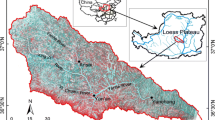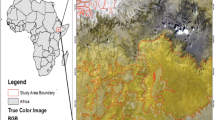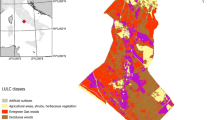Abstract
Juniperus excelsa subsp. polycarpos, (Persian juniper), is found in northeast Iran. In this study, the relationship between ground cover and vegetation indices have been investigated using remote sensing data for a Persian juniper forest. Multispectral data were analyzed based on the Advanced Visible and Near Infrared Radiometer type 2 and panchromatic data obtained by the Panchromatic Remote-sensing Instrument for Stereo Mapping sensors, both on board the advanced land observing satellite (ALOS). The ground cover was calculated using field survey data from 25 sub-sample plots and the vegetation indices were derived with 5 × 5 maximum filtering algorithm from ALOS data. R2 values were calculated for the normalized difference vegetation index (NDVI) and various soil-adjusted vegetation indices (SAVI) with soil-brightness-dependent correction factors equal to 1 and 0.5, a modified SAVI (MSAVI) and an optimized SAVI (OSAVI). R2 values for the NDVI, MSAVI, OSAVI, SAVI (1), and SAVI (0.5) were 0.566, 0.545, 0.619, 0.603, and 0.607, respectively. Total ratio vegetation index for arid and semi-arid regions based on spectral wavelengths of ALOS data with an R2 value 0.633 was considered. Results of the current study will be useful for forest inventories in arid and semi-arid regions in addition to assisting decision-making for natural resource managers.









Similar content being viewed by others
References
Anderson GL, Hanson JD, Haas RH (1993) Evaluating Landsat Thematic Mapper derived vegetation indices for estimating above-ground biomass on semiarid rangelands. Remote Sens Environ 45(2):165–175
Baret F, Guyot G (1991) Potentials and limits of vegetation indices for LAI and APAR assessment. Remote Sens Environ 35(2–3):161–173
Fadaei H, Kolahi M (2008) Transect-plot inventory, a method for arid and semi arid forests. Paper presented at the LIFO 2008 Registration Freising, Germany
Fadaei H, Sakai T, Torii K (2011) Investigation on pistachio distribution in the mountain regions of northeast Iran by ALOS. Front Agric China 5(3):393
Fadaei H, Suzuki R, Sakaic T, Toriid K (2012) A proposed new vegetation index, the total ratio vegetation index (TRVI), for arid and semi-arid regions. In: ISPRS-international archives of the photogrammetry, remote sensing and spatial information sciences, pp 403–407
FAO (2014) FAO in the Islamic Republic of Iran. http://www.fao.org/3/a-i4808e.pdf; http://www.fao.org/3/a-az240e.pdf
Fisher M, Gardner AS (1995) The status and ecology of a Juniperus excelsa subsp. polycarpos woodland in the northern mountains of Oman. Vegetatio 119(1):33–51
Gardner AS, Fisher M (1996) The distribution and status of the montane juniper woodlands of Oman. J Biogeogr 23(6):791–803
Gougeon FA, Leckie DG (2006) The individual tree crown approach applied to Ikonos images of a coniferous plantation area. Photogramm Eng Remote Sens 72(11):1287–1297
Hessenmöller D, Elsenhans AS, Schulze ED (2013) Sampling forest tree regeneration with a transect approach. Ann For Res 56(1):3–14
Huete AR (1988) A soil-adjusted vegetation index (SAVI). Remote Sens Environ 25:295–309
Kaufman YJ, Tanré D, Gordon HR, Nakajima T, Lenoble J, Frouin R, Grassl H, Herman BM, King MD, Teillet PM (1997) Passive remote sensing of tropospheric aerosol and atmospheric correction for the aerosol effect. J Geophys Res Atmos 102(D14):16815–16830
Meyer H, Lehnert LW, Wang Y, Reudenbach C, Nauss T, Bendix J (2017) From local spectral measurements to maps of vegetation cover and biomass on the Qinghai-Tibet-Plateau: do we need hyperspectral information? Int J Appl Earth Obs Geoinf 55:21–31
Ozdemir I (2008) Estimating stem volume by tree crown area and tree shadow area extracted from pan: sharpened Quickbird imagery in open Crimean juniper forests. Int J Remote Sens 29(19):5643–5655
Peng DL, Jiang ZY, Huete A, Ponce-Campos G, Nguyen U, Luvall J (2013) Response of spectral reflectances and vegetation indices on varying juniper cone densities. Remote Sens 5(10):5330–5345
Purevdorj TS, Tateishi R, Ishiyama T, Honda Y (1998) Relationships between percent vegetation cover and vegetation indices. Int J Remote Sens 19(18):3519–3535
Qi JG, Chehbouni A, Huete AR, Kerr YH, Sorooshian S (1994) A modified soil adjusted vegetation index. Remote Sens Environ 48(2):119–126
Romero-Sanchez ME, Ponce-Hernandez R (2017) Assessing and monitoring forest degradation in a deciduous tropical forest in Mexico via remote sensing indicators. Forests 8(9):302
Rondeaux G, Steven M, Baret F (1996) Optimization of soil-adjusted vegetation indices. Remote Sens Environ 55(2):95–107
Rouse JWJ, Haas RH, Schell JA, Deering DW (1974) Monitoring vegetation systems in the Great Plains with ERTS. In: Third ERTS Symposium, NASA SP-351, Washington DC, pp 309–317
Santoro M, Eriksson L, Askne J, Schmullius C (2006) Assessment of stand-wise stem volume retrieval in boreal forest from JERS-1 L-band SAR backscatter. Int J Remote Sens 27(16):3425–3454
Tavankar F (2015) Structure of natural Juniperus excelsa stands in Northwest of Iran. Biodivers J Biol Divers 16(2):161–167
Veraverbeke S, Gitas I, Katagis T, Polychronaki A, Somers B, Goossens R (2012) Assessing post-fire vegetation recovery using red–near infrared vegetation indices: accounting for background and vegetation variability. ISPRS J Photogramm Remote Sens 68:28–39
Wu YC, Strahler AH (1994) Remote estimation of crown size, stand density, and biomass on the Oregon transect. Ecol Appl 4(2):299–312
Zhang ZM, Ouyang ZY, Xiao Y, Xiao Y, Xu WH (2017) Using principal component analysis and annual seasonal trend analysis to assess karst rocky desertification in southwestern China. Environ Monit Assess 189(6):269
Author information
Authors and Affiliations
Corresponding author
Additional information
Project funding: The work was supported by the Environment Research and Technology Development Fund (S-9) of the Ministry of the Environment of Japan and JAXA’s 1st GCOM-C RA.
The online version is available at http://www.springerlink.com
Corresponding editor: Tao Xu.
Rights and permissions
About this article
Cite this article
Fadaei, H. Advanced land observing satellite data to identify ground vegetation in a juniper forest, northeast Iran. J. For. Res. 31, 531–539 (2020). https://doi.org/10.1007/s11676-018-0812-5
Received:
Accepted:
Published:
Issue Date:
DOI: https://doi.org/10.1007/s11676-018-0812-5




